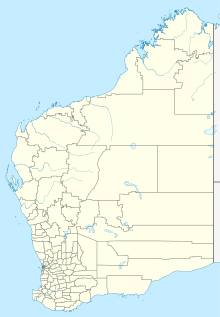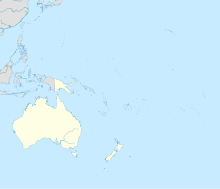
A | B | C | D | E | F | G | H | CH | I | J | K | L | M | N | O | P | Q | R | S | T | U | V | W | X | Y | Z | 0 | 1 | 2 | 3 | 4 | 5 | 6 | 7 | 8 | 9
Perth Airport | |||||||||||||||
|---|---|---|---|---|---|---|---|---|---|---|---|---|---|---|---|
 | |||||||||||||||
 Terminal 1 in 2015 | |||||||||||||||
| Summary | |||||||||||||||
| Airport type | Public | ||||||||||||||
| Owner | Utilities Trust of Australia (38%) Future Fund (30%) | ||||||||||||||
| Operator | Perth Airport Pty Ltd | ||||||||||||||
| Serves | Perth Metropolitan Region | ||||||||||||||
| Location | Perth Airport | ||||||||||||||
| Hub for | |||||||||||||||
| Focus city for | |||||||||||||||
| Elevation AMSL | 67 ft / 20 m | ||||||||||||||
| Coordinates | 31°56′24″S 115°57′54″E / 31.94°S 115.965°E | ||||||||||||||
| Website | www | ||||||||||||||
| Maps | |||||||||||||||
 | |||||||||||||||
 | |||||||||||||||
| Runways | |||||||||||||||
| |||||||||||||||
| Statistics (YE Jun-Oct 2023) | |||||||||||||||
| |||||||||||||||
Perth Airport (IATA: PER, ICAO: YPPH) is an international, domestic and general aviation airport serving Perth, the capital city of Western Australia.
It is the fourth busiest airport in Australia measured by passenger movements and falls within the boundaries of the City of Belmont, City of Kalamunda and the City of Swan.[2] Perth Airport and Jandakot Airport, the other civilian airport within the mainland Perth metropolitan area located about 20 kilometres (12 mi) south-southwest of the general aviation area of the airport,[3][a] recorded a combined total of 362,782 aircraft movements in 2017.[4]
Perth Airport covers a total of 2,105 hectares (5,202 acres) of airport property.[5]
Since 1997, it has been operated by Perth Airport Pty Ltd under a 99-year lease from the Commonwealth Government.[6]: 48
Location
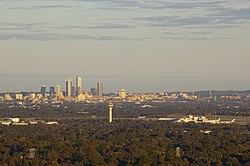
The airport is located approximately 10 km (6 mi) east of the Perth central business district. It is one of three civilian airports within the Perth metropolitan area, the others being Jandakot Airport and Rottnest Island Airport. Besides the civilian airports, there are also two military airports within the Perth metropolitan area. The larger of the two is RAAF Base Pearce, 30 km (19 mi) to the north of Perth Airport, at Bullsbrook. The other is 42 km (26 mi) south-west of Perth Airport, and is a part of the military base of HMAS Stirling on Garden Island.
Perth Airport is located on the Aboriginal traditional Whadjak-Noongar country.
Growth and impact
The airport saw strong passenger growth from 2000 to 2012, primarily due to the state's prolonged mining boom and an increase in traffic from international low-cost carrier airlines. By the end of June 2012, Perth Airport experienced passenger growth of 11.7% internationally and 6.9% domestically, resulting in an overall increase of 10.3%.[citation needed] Passenger numbers trebled in the 10 years from 2002 to 2012 with more than 12.6 million people travelling through the airport in 2012. Since 2012, the winding down of the mining boom has seen the demand for both intra- and interstate services contract, with domestic passengers falling from a peak of 9.9 million (as of June 2013) to 9.5 million by the end of June 2016. The growth in passenger numbers since 2012 has been wholly due to expansion of international services from the city. The first mining boom in 1979 had 679,000 passengers use the airport. This number now travels through the airport every eighteen days.
As well as passenger movements however, complaints about the impact of the airport on the residents of Perth have grown.[7][8] The City of Canning, one area that is affected, accepts that “aircraft noise is an important issue” and that “ does impact heavily on those suburbs under the flightpaths.”[9] Another affected area, the City of Swan, “has experienced significant issues.”[10] Indeed, planning policy adopted by the Government of Western Australia recognises that some aircraft noise is “not compatible with residential or educational” land use,[11] two fundamental uses of land in any conurbation that is home to over two million residents—such as Greater Perth.
History
Early days
Prior to the opening of the Perth Airport, civilian air services for the city were provided from Maylands Aerodrome as well as on the city's foreshore at Langley Park.[12] By the end of the 1930s, it became clear that the Maylands Aerodrome was limited in the size and speed of aircraft it was able to handle thus causing them to seek an alternative site for a future airport.[12]
Site selection and preparation of the original plans was undertaken by Mr N M Fricker of the Department of Civil Aviation.[13] In 1938, land was selected and purchased for the new aerodrome. The site selected in what was at the time Guildford, was an area of land granted by Governor James Stirling to local man John Scott, which later became the long disused Dunreath Golf Course.[12][13]
A plaque located on a roadside wall of the old International terminal remains in permanent memory of Scott:[13]
Perth Airport stands on part of an area granted originally by Governor James Stirling to John Scott. A yeoman farmer from Lanarkshire, Scotland who arrived in Western Australia in March 1831, after a voyage of about 90 days in the schooner Eliza of 343 tons. He came at the invitation of the governor, to establish and maintain a bloodstock farm for the colony. He made his home near Guildford, using the Swan River to reach the farm in this area.
In recognition of his services Governor Stirling granted him lease of an area at Bunbury, where he became the first settler in 1838.
Remember him as one who helped to bring prosperity to this land.[13]
— Text of roadside plaque in memory of John Scott.
Military operations
Even before civil aviation operations could commence at the new site, the onset of World War II saw the facility being redesigned for military purposes as a temporary base for the Royal Australian Air Force and United States Navy, known as "RAAF Station Guildford", primarily to supplement RAAF Base Pearce.[12] Royal Australian Air Force No. 85 Squadron was based there from February 1943.
Despite military use of the airfield, civil services operated by Qantas Empire Airways and Australian National Airways (ANA) commenced from the location in 1944.[12] This was despite bitter protest from military authorities who felt civilian operations would undermine the defence and camouflage needs of the location.[12]
The move was agreed to by the government, as the larger types of aircraft of the day being operated by the two airlines could simply not be handled at Maylands, notwithstanding the small grass airfield, lack of passenger facilities, and approaches being difficult due to surrounding industrial infrastructure.[12] Using Douglas DC-3 aircraft, ANA flew the first commercial service from the aerodrome to Adelaide.[12] On 17 June 1944, Qantas made its inaugural flight to Ceylon via Exmouth using a modified Consolidated B-24 Liberator, arriving in Perth on 3 June 1944 having been released to the airline by the British Government.[12]
Early civilian operations
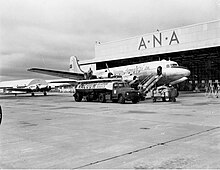
Full civilian operations at the Guildford Aerodrome commenced in 1944.[13] Civil operations at Maylands continued albeit reduced until 30 June 1963, when the airport closed and its function as a secondary airport was taken over by Jandakot Airport the very next day.[12]
Guildford Aerodrome was at best only a basic airfield.[12] On a large open airfield with plenty of space, an unobtrusive control tower was hidden away amongst a collection of buildings inherited from the wartime operations at the site.[12] The Department of Civil Aviation inherited a large number of operating vehicles from the former military occupants, including an assortment of vehicles including (Ford or Chevrolet) Blitz wagons, Dodge command cars and weapon carriers, large trucks and various makes of fire tenders, jeeps and ambulances.[12] Boarding aircraft at Guildford was described as being a bit like boarding a bus given the lack of passenger facilities at the time.[12]
In 1948, the Horrie Miller owned MacRobertson Miller Airlines (MMA) relocated from Maylands to Guildford.[12] followed by newly formed government airline Trans Australia Airlines (TAA) on 2 December of that same year, operating Douglas C-54 Skymasters on its Perth – Melbourne – Sydney route.[12] Due to the lack of road transportation across the Nullarbor Plain, it was at this time that Guildford became the scene of very busy cargo operations.[12] Fresh fruit, vegetables and manufactured goods were being flown from east to west and back again.
The airport was granted international status in September 1952, and renamed from Guildford Aerodrome to Perth Airport in March 1953.[14][15][16] Officiated by the Federal Minister for Civil Aviation, Hubert Anthony, the official ceremony for the renaming took place on the main apron in front of a converted Bellman hangar used by TAA as its passenger terminal.[12] At the time, a new international terminal building was under construction but had not been completed in time for the ceremony.[12] This new terminal was being constructed using steel and cladding recycled from American-built military quonset buildings being dismantled and shipped over from Manus Island.[12]
It was also on this day that Qantas commenced its Wallaby service using Lockheed Constellations from Sydney to South Africa via Perth, the Cocos Islands and Mauritius.[12]
The jet age

Towards the mid-1950s, airline travel was still being used by only a small percentage of the population. At that time, only 8% of the population had ever flown, but as the marketplace evolved, so did the types of people and their reasons for flying.[12]
It was at this time the airport began to experience the full effects of the jet age. Although both Air India and Qantas commenced operating Boeing 707s in the mid to late 1950s from Perth to Singapore and the sub continent,[12] as the aircraft of the day grew faster and more demanding due to their sophistication, facilities at the airport continued to improve to accommodate them.[12] By the mid-1960s the airport commenced seeing its first domestic pure jet engine aircraft, commencing with a Boeing 727 in 1964, and the Douglas DC-9 in 1967, both types operated by TAA and Ansett ANA.[12] It was at this time that the airport was one of the few major airports in the country which operated without curfews, and due to the increased number and frequency of flights operating from the airport it gave birth to what was then referred to as the midnight horror or red-eye special, known in more recent history as the red-eye flight.[12]
Demise of the hangar terminals
In 1960, the then international terminal previously constructed from steel and cladding from Manus Island was dismantled and then re-erected in the suburb of Cannington.[12] Known as The Alco Building, it was re-designed for use as a commercial facility.[12]
The removal of the steel structure made way for the construction of an entirely new combined domestic and international passenger terminal, constructed on the northern side of the airfield.[12] It was in 1962 that airlines were able to move from their hangars into a new combined passenger terminal, designed by the Commonwealth Department of Works and opened just in time to handle 1962 British Empire and Commonwealth Games traffic increases.[12][13] The new combined terminal was opened that same year by then Minister for Civil Aviation, Senator Shane Paltridge; it was built in an area positioned between the present Terminals 3 and 4 and is currently used as the crew base for both Qantas and Jetstar, and offices for airlines and support firms.[12][17]
International terminal development
From 1962 onwards, both the domestic and international passenger operations at the airport were provided by a single terminal.[17] However, by the arrival of the Boeing 747 on 3 September 1971, the existing terminal had reached its capacity, and modelling of future passenger numbers showed it would be unable to handle any further increases in passenger demand.[12][17]
In November 1980, the Federal Transport Minister, Ralph Hunt, announced that a new international terminal would be built in Perth at a cost of $26 million (1980).[12] Design of the new International Terminal commenced in 1982, with one of the key principles of the design being the allowance for easy future expansion as the needs of the airport dictated.[17] The project called for the construction of a new terminal, apron, airside roads, access roads, car parks and other passenger facilities.[17]
Construction of the new International Terminal and control tower commenced in March 1984 on the south-eastern side of the airfield.[17] In 1984, the road leading to the new terminal, Horrie Miller Drive was named in honour of local aviation pioneer Horrie Miller.[18] The terminal was officially opened on 25 October 1986 by Prime Minister Bob Hawke, with the new terminal receiving passengers just days after.[12][17] The newly built control tower was the tallest in Australia at the time of its construction, and remains the tallest in Australia.[19]
Upon completion, the terminal was able to process up to five Boeing 747 aircraft per hour and accommodated a peak passenger volume of 6,000 passengers per hour.[17] Twenty years later, in the 12 months to June 2006 the terminal processed over 2.027 million passengers, surpassing a 1996 projection of 1.016 million passengers in that period.[17]
1988 onwards

In the late 1980s the Federal Government, as a prelude to eventual privatisation, formed the Federal Airports Corporation (FAC). In 1988, the FAC took over as manager of Perth Airport (and many other Australian airports).[12]
At this time also, airline operators Qantas and Ansett set about on ambitious capital works programs to construct new domestic terminals for their respective airlines on the northern side of the terminal, where they still stand to this day.[12] In 2001, after the financial collapse of Ansett, the Ansett terminal became a multi-user terminal, catering for flights from former Ansett-subsidiary Skywest, as well as Virgin Australia and now charter airlines including Alliance Airlines and previously Air Australia. The Ansett terminal is known now as Terminal 1 Domestic, and the old International terminal is known as Terminal 1 International. The Air Australia and Qantas terminal is now Terminal 3-4, operating flights by Qantas and Jetstar.
In July 1997 Perth Airport Pty Ltd took up a 99-year lease as part of the Federal Government's push to privatise airports.[20] As at February 2021, Utilities Trust of Australia (38%) and Future Fund (30%) were the major shareholders.[21]
From 2003 to 2004, the International terminal underwent major internal refurbishments to provide an increased array of passenger services, including increased space for duty-free stores and food and beverage concession stands.[17] Further upgrades valued at $25 million (2006) were made to the terminal across 2005 and 2006 which added an additional 2,500 m2 (27,000 sq ft) of floor space, additional check-in counters, and an improved baggage handling and screening system.[17]
The airport commemorated its 60th anniversary in 2004, with an event that opened the new Taxiway Sierra, a new taxiway supporting larger aircraft such as the Boeing 747, Airbus A340 and Airbus A380.[22]
On 14 October 2008, the Airbus A380 made its first visit to the airport as a part of Qantas' A380 promotional tour around Australia. The second A380 to visit the airport was an Emirates aircraft which made an emergency landing on 15 August 2009, after a passenger on a Dubai to Sydney flight suffered a stroke.[23]
In 2012, the Australian Competition & Consumer Commission (ACCC) released a report rating the Perth Airport as the worst in Australia, as judged by airlines. The same report rated it below satisfactory for the second year in a row.[24] However, due to more recent expansions and projects, the airport was awarded Capital City airport of the year by the Australian Airports Association at their national conference in 2016.[25] In 2018, Perth Airport was named the best airport in Australia for overall service quality by the ACCC after the completion of a $1 billion redevelopment project over the span of 5 years.[26]
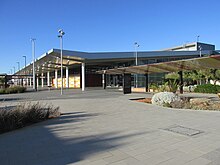
Terminal 2 was officially opened on 28 February 2013, with the first flights operating out of the terminal from 2 March 2013. The single story terminal features at-grade access to the terminal building and dedicated pick-up and drop-off lanes at the front of the terminal, a centralised passenger security screening zone, three baggage reclaim belts as well 14 aircraft bays, accessible from enclosed walkways and serviced by 8 boarding counters, and 36 additional aircraft parking bays.[27]

In April 2015 works commenced on a $42 million upgrade of the forecourt and the passenger pick-up/drop-off areas in front of Terminal 1 to improve access.[28] The upgrade was completed in November 2016.[29]
In May 2015, Emirates commenced the first Airbus A380 service to Perth from Dubai following the completion of a dual level boarding gate, an expanded check-in hall, a refurbished departure area and other expansions to Terminal 1 including a new Emirates business class lounge.[30][31] In August 2017, Emirates replaced its last remaining Emirates Boeing 777-300ER service with an Airbus A380, taking the total Emirates daily services to two.[32] However, this service was replaced by a Boeing 777 in 2020, during the COVID-19 pandemic. On 1 November 2022, the first regular A380 service resumed.

On 22 November 2015 the domestic pier of Terminal 1 was opened; the pier became the exclusive home to Virgin Australia.[33] Virgin Australia's partner, Etihad Airways began daily direct services from its hub in Abu Dhabi on 16 July 2014;[34] the pier ensures quick and seamless transfers between the two airlines. The pier will also be connected to Terminal 2 via an elevated walkway allowing seamless transfer to Virgin's regional services without having to be re-screened.
On 15 May 2016, the world's largest commercial jet airliner, the Antonov An-225 Mriya landed at Perth Airport, making its first visit to Perth and Australia.
On 3 November 2016, construction of a commuter rail link to the airport was started, with Airport Central station on the Airport line linking the future consolidated terminal precinct with the greater Transperth railway network.[35] The Airport line, which opened on 9 October 2022 and is underground below Perth airport, converges with the Midland line at Bayswater station.[36][37] Also constructed was a pedestrian "skybridge" linking the station to Terminal 1.[38]
On 11 December 2016, Qantas announced that it would commence non-stop flights from Perth to London Heathrow with one of its newly acquired Boeing 787 Dreamliners. To achieve this the Qantas domestic terminal at T3/T4 was upgraded during 2017 to cater for international flights. Once completed the existing Qantas flights to Singapore and Auckland also migrated to the same terminal. All Qantas’ international flights now depart from Terminal 3’s International section. Services to London started in March 2018.[39][better source needed]. In June 2022 Qantas began direct flights from Perth to Rome to be operated on a seasonal basis, three times a week, this created Perth Airports second direct connection to Europe.[40] These services will be followed by a direct service to Paris Charles de Gaulle beginning in July 2024, the third connection to Europe.[41]
In May 2018, Qatar Airways upgraded their Perth-Doha service from the Boeing 777 to the Airbus A380, making them the second airline to begin A380 services to Perth.[42] Although this service was downgraded in 2020 during the COVID-19 pandemic, Qatar Airways would ultimately resume A380 services to Perth in December 2022.[43]
In May 2024, it was announced that terminals T3 and T4 will receive upgrades to create additional capacity for Qantas services before the airline ultimately moves to a new terminal in the Airport Central precinct in 2031.[44] In addition, domestic Jetstar services will move to T2 from September 2024, before rejoining Qantas at the new terminal once it is completed.[44] These upgrades will cost an estimated $5 billion AUD which will include both the new terminal and runway.[45]
Facilities and services
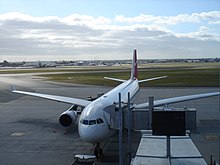
Perth Airport has five terminals: four main terminals and one minor terminal.[46]

- On the eastern side of the airport (and the location of the future consolidated terminal precinct) are:
- Terminal 1 (T1), originally known as the International Terminal, caters primarily for flights originating or departing outside Australia, with five jetways and a total of seven gates including a Multi Access Ramp System which allows dual boarding of aircraft including the Boeing 777 and Airbus A380. There are four airline lounges: the Emirates lounge; a Singapore Airlines Silver Kris lounge; the Air New Zealand Lounge and the unaffiliated Aspire Lounge. The Emirates lounge has a second level and offers direct boarding on their flagship Airbus A380 aircraft. In November 2015, a new domestic pier opened at the west end of T1 to service Virgin Australia domestic flights. The domestic pier has eight gates and contains a Virgin Australia lounge. It is connected to T2 by a walkway.
- Terminal 2 (T2) is located to the immediate south west of T1 and caters for regional services. Virgin Australia Regional and Alliance commenced operations from T2 in 2013 whilst Rex Airlines commenced operations from T2 in 2016.[47] It contains an Alliance lounge.
- On the western side of the airport are the remaining terminals; terminals T3 and T4 adjoin each other, with Qantas Group having exclusive use of both terminals since the movement of Virgin Australia to T1. The Perth Airport Master Plan outlines these two terminals will ultimately be demolished and replaced by a single new terminal east of T1.
- Terminal 3 (T3) has five jetways and a total of nine gates. Since November 2015, it is currently primarily used by Jetstar domestic flights, although some Qantas services also operate from the terminal. Since March 2018, Qantas international departures have taken place at T3, having moved from T1; for this purpose the terminal has been outfitted with customs and immigration facilities, and contains an international arrivals concourse.[48] T3 contains two Qantas lounges, with one dedicated to the airline's international passengers.
- Terminal 4 (T4) has four jetways and a total of nine gates and is dedicated to the domestic operations of Qantas, QantasLink and Jetstar. The terminal also facilitates check in for Qantas' international services. It has two member lounges: The Qantas Club, which was expanded in March 2013 to cater for an additional 140 passengers;[49] and the Qantas Domestic Business Lounge, which opened in 2014.
- There is also a general aviation terminal to the north of T3 and T4 simply called General Aviation that is used primarily by some charter aircraft and for mining companies with fly-in fly-out services, with Jandakot airport also serving that function.
Runways
Flights are serviced by two runways – the main 03/21 runway, 3,444 m × 45 m (11,299 ft × 148 ft) and 06/24, 2,163 m × 45 m (7,096 ft × 148 ft).
In 1965, Runway 03/21 was extended from 7,500 ft (2,286 m) to 10,000 ft (3,048 m) to accommodate Boeing 707s.[50]
After a 10-month project, a reconstructed cross runway was opened on 21 October 2005.[51] The upgrades involved significant strengthening works and enlargement of turning nodes to accommodate regular operations by wide bodied aircraft, including the Airbus A380.[51]
Meteorological services
Meteorological services for Perth Airport commenced in May 1944, provided by the Guildford Meteorological Office situated at Ivy Street, Redcliffe.[52]
In March 1988, surface observations were moved to the recently vacated old airport tower on the northern side of the airfield (near what is now Terminal 3).[52] The Ivy Street location was retained for a time for radar services and the launching and tracking of weather balloons.[52] In October 1997, all operations from the Ivy Street Office and Old Control Tower were transferred to a newly constructed office on the Northern Perimeter Road in Belmont, in the north-eastern corner of the airfield.[52]
Landing patterns and approach
Perth Airport resides within the Melbourne FIR, which is managed by Melbourne Centre and operated by Airservices Australia.[53]
Observation areas
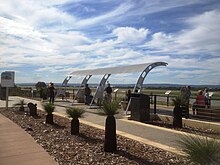
There are two dedicated spotting areas at Perth Airport. Terminal T1 has an Observation Deck on level 3 to view departing and arriving aircraft. It has vending machines, toilets and flight information displays.
The second spotting area is to the west side opposing the threshold of Runway 03 located along Dunreath Drive. The public viewing area has a shelter in the shape of the body section of a Boeing 747, and displays of information about the history of aviation.[54]
Other services
The Australian Transport Safety Bureau has its Perth regional office on Level 2 of the Hkew Alpha Building on the property of Perth Domestic Airport.[55]
Since May 2014, terminals T1 International, T2 Regional and T3 Domestic have a free Wi-Fi connection currently powered by iiNet. It is accessible throughout the entirety of the departure and arrival areas. Currently, T4 Qantas Domestic also has a free Wi-Fi service provided by Qantas.
The Royal Automobile Club of Western Australia (RAC) had a purpose-built driver training facility at Perth Airport, the only one of its kind in the state.[56] It was located towards the east of the current T1 International Terminal on Grogan Road.
Airlines and destinations
This section needs additional citations for verification. (July 2021) |
Perth Airport is served by 30 scheduled airlines flying to over 50 destinations in Australia, Oceania, Asia, Africa and Europe. A total of 1258 scheduled domestic and regional flights arrive and depart from Perth Airport each week. On the international front, a total of 213 scheduled[57] international flights arrive and depart from Perth Airport each week. The following carriers operate to the following destinations:[58][better source needed]
Passenger
Cargo
| Airlines | Destinations |
|---|---|
| Qantas Freight[88] | Melbourne, Adelaide |
| Qatar Airways Cargo[89] | Doha |
Operations and statistics
Totaledit
Total passengers using the airport has increased on average by 2.5% annually since 1998 to 2022, with 78% of passenger traffic at the airport attributed to domestic travel in 2022.[90]


Graphs are unavailable due to technical issues. There is more info on Phabricator and on MediaWiki.org. |
| Year | Domestic | International | Total | Change |
|---|---|---|---|---|
| 1998 | 3,235,524 | 1,434,077 | 4,669,601 | |
| 1999 | 3,257,087 | 1,474,898 | 4,731,985 | |
| 2000 | 3,463,122 | 1,580,622 | 5,043,744 | |
| 2001 | 3,341,803 | 1,587,379 | 4,929,182 | |
| 2002 | 3,371,315 | 1,636,422 | 5,007,737 | |
| 2003 | 3,892,623 | 1,586,622 | 5,479,245 | |
| 2004 | 4,437,291 | 1,827,389 | 6,264,680 | |
| 2005 | 4,754,672 | 2,007,025 | 6,761,697 | |
| 2006 | 5,429,870 | 2,034,877 | 7,464,747 | |
| 2007 | 6,105,246 | 2,373,568 | 8,478,814 | |
| 2008 | 6,705,180 | 2,533,022 | 9,238,202 | |
| 2009 | 6,841,037 | 2,774,737 | 9,615,774 | |
| 2010 | 7,319,853 | 3,133,709 | 10,453,562 | |
| 2011 | 8,016,032 | 3,349,468 | 11,365,500 | |
| 2012 | 8,999,571 | 3,618,768 | 12,618,339 | |
| 2013 | 8,981,872 | 3,919,840 | 12,901,712 | |
| 2014 | 8,758,519 | 4,180,407 | 12,938,926 | |
| 2015 | 8,401,532 | 4,192,833 | Zdroj:https://en.wikipedia.org?pojem=Perth_Airport


